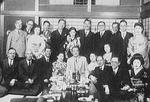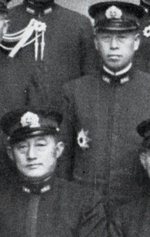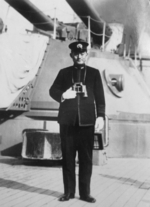Mitsumasa Yonai
| Surname | Yonai |
| Given Name | Mitsumasa |
| Born | 2 Mar 1880 |
| Died | 20 Apr 1948 |
| Country | Japan |
| Category | Government |
| Gender | Male |
Contributor: C. Peter Chen
ww2dbaseMitsumasa Yonai was born in Morioka, Iwate Prefecture, Japan to a samurai. He graduated from Imperial Japanese Naval Academy at Etajima in 1901, and was promoted to the rank of ensign in Jan 1903. He was a veteran of the Russo-Japanese War of 1904-1905, and during WW1 he served in Russia and Poland as military attaché and Resident Naval Officer. He was recalled to Japan after the fall of Imperial Russia and was assigned the commander of the Sasebo Naval District.
ww2dbaseDuring the inter-war period, Yonai served in a variety of duties, both sea going and land bound. In 1918, he was appointed to the Naval General Staff. In Dec 1920, he was promoted to the rank of captain. Between Nov 1924 and Dec 1925, he was the commander of the battleship Mutsu. In Dec 1925, he was promoted rear admiral and became the chief of staff of the Second Fleet. In Dec 1928, he took command of the First Expeditionary Fleet and led a fleet in China, which success led him to a promotion to the rank of vice admiral. In Dec 1930, he served as commander of the Chinkai Naval Station in Korea. Between Dec 1932 and Dec 1936, he commanded various fleets and naval districts.
ww2dbaseIn Dec 1936, as war loomed on the horizon, Yonai took command of the Combined Fleet. He was promoted full admiral in Apr 1937, and then became Navy Minister to Prime Ministers Senjuro Hayashi, Fumimaro Konoe, and Kiichiro Hiranuma. After Nobuyuki Abe became Prime Minister, Yonai remained on the Supreme War Council. As a politician, he was alarmed by the potential for war between Japan and and Britain and United States. His efforts to avert war made him target of several unsuccessful assassination attempts by his conservative political opponents. On 6 Jan 1940, he was appointed Prime Minister of Japan, a move backed by Emperor Showa, while maintaining the position of Navy Minister concurrently. His short tenure ended on 21 Jul 1940 as he was forced to resign largely due to the influence of the hawkish Japanese Army; Yonai's continued and outspoken resistance to an alliance with Germany made him extremely unpopular with the Army officers in power. Yonai served as Deputy Prime Minister and concurrently as Navy Minister under the cabinet of Prime Minister Kuniaki Koiso from 22 Jul 1944. Near the end of the war, he was the Navy Minister under Prime Minister Kantaro Suzuki. In the final weeks of the war, he sided with the doves who believed Japan should surrender to the Allied powers in order to avoid further destruction. Although he believed Japan should accept the terms of the Potsdam Declaration, he also believed that the position of Emperor Showa should be preserved after the war.
ww2dbaseYonai was known to his colleagues as a man of few words. His speeches were often short and were delivered with his heavy Nambu accent. However, he did not require skills as a speaker to demand respect, for that his tenure, both military and political, spoke volumes of his capability.
ww2dbaseAfter the war, Yonai presided over the final dissolution of the Japanese Navy as demanded by the Allied powers. He was interrogated in Japan in Oct 1945; the interrogator noted that Yonai was "certainly one of the strong men of present day Japan, intelligent, forceful, and straightforward."
ww2dbaseYonai died of pneumonia in 1948.
ww2dbaseSources: Interrogations of Japanese Officials, Wikipedia.
Last Major Revision: Mar 2007
Mitsumasa Yonai Interactive Map
Photographs
 |  |  |  |
Mitsumasa Yonai Timeline
| 2 Mar 1880 | Mitsumasa Yonai was born in Morioka, Iwate, Japan. |
| 1 Dec 1930 | Admiral Mitsumasa Yonai was named the commanding officer of Chinkai Guard District in southern Korea. |
| 1 Dec 1936 | Mitsumasa Yonai was named the commander-in-chief of the Japanese Navy Combined Fleet. |
| 20 Apr 1948 | Mitsumasa Yonai passed away. |
Did you enjoy this article or find this article helpful? If so, please consider supporting us on Patreon. Even $1 per month will go a long way! Thank you. Share this article with your friends: Stay updated with WW2DB: |
» Mutsu
Document(s):
» Imperial Rescript for Surrender
» Interrogation Nav 76, Admiral Mitsumasa Yonai
- » 1,150 biographies
- » 337 events
- » 43,917 timeline entries
- » 1,241 ships
- » 350 aircraft models
- » 207 vehicle models
- » 375 weapon models
- » 123 historical documents
- » 260 facilities
- » 470 book reviews
- » 28,545 photos
- » 432 maps
Winston Churchill
Please consider supporting us on Patreon. Even $1 a month will go a long way. Thank you!
Or, please support us by purchasing some WW2DB merchandise at TeeSpring, Thank you!